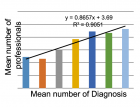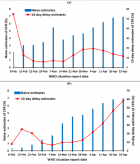Abstract
Research Article
Anti-nutrient and mineral properties of Complementry Food produced from Malted Red Sorgum and Defatted Soybean Flour Blend
Oloye DA*, Agbaje RB, Olatunji CA and Olawale-Olakunle OE
Published: 31 August, 2017 | Volume 1 - Issue 1 | Pages: 033-038
This study was aimed at producing a high nutritious food that will meet the nutritional requirements of consumers. Blends of malted red sorghum and defatted soybeans flour were processed and the resulting flours were formulated at ratios of 100:00; 95:5; 90:10 and 80:20 (malted red sorghum: defatted soybeans flour). The resulting products were subjected to antinutrients and minerals properties determination. The results obtained showed that the antinutrients decreased linearly with increase in the mineral elements. Antinutrients in the blends decreased from 2.25-1.80mg/g (oxalate); 2.45-2.16mg/g (phytate); 14.16-9.26g/100g (Alkaloids); 2.12-1.69/100g (saponin) and 0.18-0.13mg/g (Tannin). A percentage increase of 12.6% (sodium); 10.8% (calcium); 9.5% (potassium); 3.7% (magnesium) and 14.1% (Iron) was recorded as the quantity of defatted soybeans flour increased in the blends. The low levels of antinutrients in the blends produced make them safe and suitable for human consumption. Substitution of malted red sorghum with 20% defatted soybean flour showed a remarkable improvement in the mineral contents of the diets
Read Full Article HTML DOI: 10.29328/journal.afns.1001006 Cite this Article Read Full Article PDF
Keywords:
Antinutrient; Complementary; Malted; Flour; Mineral
References
- Murray CJ, Lopez AD. Global Mortality, disability and the contribution of risk factors: Global burden of disease study. Lancet. 1997; 349: 1436-1442. Ref.: https://goo.gl/8goaZa
- Granthan-Mcgregor S, Cheung YB, Cueto S, Glewwe P, Richter L, et al. Developmental potential in the first 5years for children in developing countries. Lancet. 2007; 369: 60-70. Ref.: https://goo.gl/CsNFJa
- Onweluzo JO, Nwabugwu CC. Development and evaluation of weaning foods from pigeon pea and millet. Pakistan J Nutri. 2009; 8: 725-730. Ref.: https://goo.gl/TW1Sri
- Caulfield LE, Zava aleta N, Figueoroa A. Adding Zinc to prenatal iron and Folate supplement improves maternal and neonatai zinc status in a Peruvian Population. Am J Clin Nutr. 1999; 69: 1257-1263. Ref.: https://goo.gl/5awiQd
- Food and Agriculture Organization. Sorghum and Millets in Human Nutrition: Chapter 5. Nutritional quality of foods prepared from Sorghum and Millets. FAO Corporate Document Repository. 2009. Ref.: https://goo.gl/wccdXH
- Giampietro PG, Bruno G, Furcolo G, Casali A, Brunetti E, et al. Soy Protein Formulas in Children: No Hormonal Effects in Long-Term Feeding. J Pediatr Endocrinol Metab. 2004; 17: 191-196. Ref.: https://goo.gl/MsNJPK
- Anderson JW, Johnstone BM, Cook-Newell ME. Meta-Analysis of the Effects of Soy Protein Intake on Serum Lipids. New England J Med. 1995; 333: 276-282. Ref.: https://goo.gl/PRdWsB
- Ene-Obong HN, Carnovale E. A comparison of the proximate, minerals and amino acid composition of some known and lesser known legumes in Nigeria. Food Chem. 1992; 43: 169-175. Ref.: https://goo.gl/yxd1eR
- Strom BL, Schinnar R, Ziegler EE, Barnhart KT, Samuel MD, et al. Soybeans, Production/crops/World for 2014. FAOSTAT. 2015. Ref.: https://goo.gl/BRceTr
- Hellen E, Ibenglu S, Ainsworth P. Effect of fermented and germinated cowpea flour addition on the rheological and bakery properties of wheat flour. J Food Engr. 2003; 63: 177-184. Ref.: https://goo.gl/v1VYv4
- Iwe MO. The Science and Technology of Soybean: Chemistry, Nutrition, Processing and utilization 1 Edition. Rejoin commun serv Enugu. 115-146.
- Official method of analysis, 17 (ED). Association of Official Analytical Chemist. AOAC. 2000; 2:112-120. Ref.: https://goo.gl/AfNgHd
- Lauren AC, Mendoza EMT. Effects of soaking in aqueous, acidic and alkaline solution on removal of polyphenols and in-vitro digestibility of cowpea. Plant Food Human Nutr. 1986; 36: 107-118. Ref.: https://goo.gl/k7WtYn
- Onwuka GI. Physicochemical, Nutritional and Functional Properties of the Epicarp, Flesh and Pitted Sample of Doum Fruit (Hyphaene Thebaica). J food Nutr res. 2005; 2: 129-149. Ref.: https://goo.gl/dUwYVg
- Ene-Obong HN, Obizora IC. Effect of dosmestic processing on the cooking time, nutrients, antinutients and in-vitro protein digestibility of the Africa yam bean (Sphenostylis stenocarpa). Plant food Human Nutr. 1996; 49: 43-52. Ref.: https://goo.gl/sqodHN
- Osagie AU. Antinutrient factors. In: Nutritional Quality of Plant Foods. 1998; 37-49. Ref.: https://goo.gl/LQeM7k
- Akinyeye RO, Oluwadunsi O, Omoyeni A. Proximate, minerals, antinutient and phytochemical screening and amino acid composition of the leaves of Pterocarpus mildraedi harms. Electr J Environ, Agricul Food Chem. 2011; 10: 1848-1857. Ref.: https://goo.gl/BpAoer
- Miniello VL, Moro GE, Tarantino M, Natile M, Granieri L. Soybean based Formulas and Phyto-oestrogens: A Safety Profile. Acta Paediatrica. 2003; 92: 93-100. Ref.: https://goo.gl/NYpR4k
- Ferro C, Deelstra H, Ulietink A. Condensed vegetable tannins. Biochemical Systematic and Ecology. 2005; 454-459.
Similar Articles
-
Effect of storage period on the quality characteristics of two varieties of African Mango Seed Flour at ambient temperatureAdedeji TO*. Effect of storage period on the quality characteristics of two varieties of African Mango Seed Flour at ambient temperature. . 2017 doi: 10.29328/journal.afns.1001002; 1: 012-019
-
Anti-nutrient and mineral properties of Complementry Food produced from Malted Red Sorgum and Defatted Soybean Flour BlendOloye DA*,Agbaje RB,Olatunji CA,Olawale-Olakunle OE. Anti-nutrient and mineral properties of Complementry Food produced from Malted Red Sorgum and Defatted Soybean Flour Blend. . 2017 doi: 10.29328/journal.afns.1001006; 1: 033-038
-
Effect of Pre-Treatments and Drying Methods on the Chemical Quality and Microbial Density of Wild Edible Oyster MushroomIbrahim TA*,Adaramola-Ajibola KM,Adesuyi AT,Olanrewaju SO,Akinro EB. Effect of Pre-Treatments and Drying Methods on the Chemical Quality and Microbial Density of Wild Edible Oyster Mushroom. . 2017 doi: 10.29328/journal.afns.1001007; 1: 039-044
-
Assessment of Complementary Feeding Practice of infants and young children aged 6-23 months in Gode Town, Somali Regional State of EthiopiaYimer Mihretie*. Assessment of Complementary Feeding Practice of infants and young children aged 6-23 months in Gode Town, Somali Regional State of Ethiopia. . 2017 doi: 10.29328/journal.afns.1001008; 1: 045-057
-
Chemical composition and organoleptic properties of Cocoyam starch-wheat flour blend noodlesAdedeji Temileye Omotayo*. Chemical composition and organoleptic properties of Cocoyam starch-wheat flour blend noodles. . 2017 doi: 10.29328/journal.afns.1001009; 1: 058-062
-
Evaluation of Clupeids and Danish fish meal based diets on the growth of African catfish, Clarias gariepinus fingerlingsLenient MO Ibiyo*,Rowland MO Kayode,A Oresegun, Oluwaseyi Mogaji,Felicia O Joshua. Evaluation of Clupeids and Danish fish meal based diets on the growth of African catfish, Clarias gariepinus fingerlings. . 2018 doi: 10.29328/journal.afns.1001014; 2: 031-037
-
Lemongrass tea consumption and changes in Acid-Base Balance and Electrolyte homeostasisChristopher E Ekpenyong*. Lemongrass tea consumption and changes in Acid-Base Balance and Electrolyte homeostasis. . 2018 doi: 10.29328/journal.afns.1001016; 2: 041-051
-
Quality Evaluation of Sorghum bicolor Stem Sheath Enriched with Spondias mombin ExtractAdedeji TO*. Quality Evaluation of Sorghum bicolor Stem Sheath Enriched with Spondias mombin Extract. . 2020 doi: 10.29328/journal.afns.1001022; 4: 012-019
-
Effect of ginger flour supplementation on fermented millet flour ‘ibyer’ anti-diabetic and biochemical propertiesOgori AF*,Adakole MI,Ikya JK,Girgih AT,Upev V. Effect of ginger flour supplementation on fermented millet flour ‘ibyer’ anti-diabetic and biochemical properties. . 2020 doi: 10.29328/journal.afns.1001025; 4: 029-035
-
Perceptions of Adolescent Mothers on Feeding and Nutrition of their Children aged 0-3 Years in Rural BangladeshFaiza Farzana*, Tanvir Sarwar. Perceptions of Adolescent Mothers on Feeding and Nutrition of their Children aged 0-3 Years in Rural Bangladesh. . 2023 doi: 10.29328/journal.afns.1001050; 7: 054-064
Recently Viewed
-
The efficacy of complex Decongestive Physiotherapy in patients with Bilateral Primary Lower Extremity Lymphedema and Untreatable multiple health conditions: A Case ReportHümeyra Kiloatar PT*. The efficacy of complex Decongestive Physiotherapy in patients with Bilateral Primary Lower Extremity Lymphedema and Untreatable multiple health conditions: A Case Report. J Nov Physiother Rehabil. 2017: doi: 10.29328/journal.jnpr.1001011; 1: 093-098
-
Cystoid Macular Oedema Secondary to Bimatoprost in a Patient with Primary Open Angle GlaucomaKonstantinos Kyratzoglou*,Katie Morton. Cystoid Macular Oedema Secondary to Bimatoprost in a Patient with Primary Open Angle Glaucoma. Int J Clin Exp Ophthalmol. 2025: doi: 10.29328/journal.ijceo.1001059; 9: 001-003
-
Metastatic Brain Melanoma: A Rare Case with Review of LiteratureNeha Singh,Gaurav Raj,Akshay Kumar,Deepak Kumar Singh,Shivansh Dixit,Kaustubh Gupta*. Metastatic Brain Melanoma: A Rare Case with Review of Literature. J Radiol Oncol. 2025: doi: ; 9: 050-053
-
Depression as a civilization-deformed adaptation and defence mechanismBohdan Wasilewski*,Olha Yourtsenyuk,Eugene Egan. Depression as a civilization-deformed adaptation and defence mechanism. Insights Depress Anxiety. 2020: doi: 10.29328/journal.ida.1001013; 4: 008-011
-
Drinking-water Quality Assessment in Selective Schools from the Mount LebanonWalaa Diab, Mona Farhat, Marwa Rammal, Chaden Moussa Haidar*, Ali Yaacoub, Alaa Hamzeh. Drinking-water Quality Assessment in Selective Schools from the Mount Lebanon. Ann Civil Environ Eng. 2024: doi: 10.29328/journal.acee.1001061; 8: 018-024
Most Viewed
-
Evaluation of Biostimulants Based on Recovered Protein Hydrolysates from Animal By-products as Plant Growth EnhancersH Pérez-Aguilar*, M Lacruz-Asaro, F Arán-Ais. Evaluation of Biostimulants Based on Recovered Protein Hydrolysates from Animal By-products as Plant Growth Enhancers. J Plant Sci Phytopathol. 2023 doi: 10.29328/journal.jpsp.1001104; 7: 042-047
-
Sinonasal Myxoma Extending into the Orbit in a 4-Year Old: A Case PresentationJulian A Purrinos*, Ramzi Younis. Sinonasal Myxoma Extending into the Orbit in a 4-Year Old: A Case Presentation. Arch Case Rep. 2024 doi: 10.29328/journal.acr.1001099; 8: 075-077
-
Feasibility study of magnetic sensing for detecting single-neuron action potentialsDenis Tonini,Kai Wu,Renata Saha,Jian-Ping Wang*. Feasibility study of magnetic sensing for detecting single-neuron action potentials. Ann Biomed Sci Eng. 2022 doi: 10.29328/journal.abse.1001018; 6: 019-029
-
Pediatric Dysgerminoma: Unveiling a Rare Ovarian TumorFaten Limaiem*, Khalil Saffar, Ahmed Halouani. Pediatric Dysgerminoma: Unveiling a Rare Ovarian Tumor. Arch Case Rep. 2024 doi: 10.29328/journal.acr.1001087; 8: 010-013
-
Physical activity can change the physiological and psychological circumstances during COVID-19 pandemic: A narrative reviewKhashayar Maroufi*. Physical activity can change the physiological and psychological circumstances during COVID-19 pandemic: A narrative review. J Sports Med Ther. 2021 doi: 10.29328/journal.jsmt.1001051; 6: 001-007

HSPI: We're glad you're here. Please click "create a new Query" if you are a new visitor to our website and need further information from us.
If you are already a member of our network and need to keep track of any developments regarding a question you have already submitted, click "take me to my Query."

















































































































































